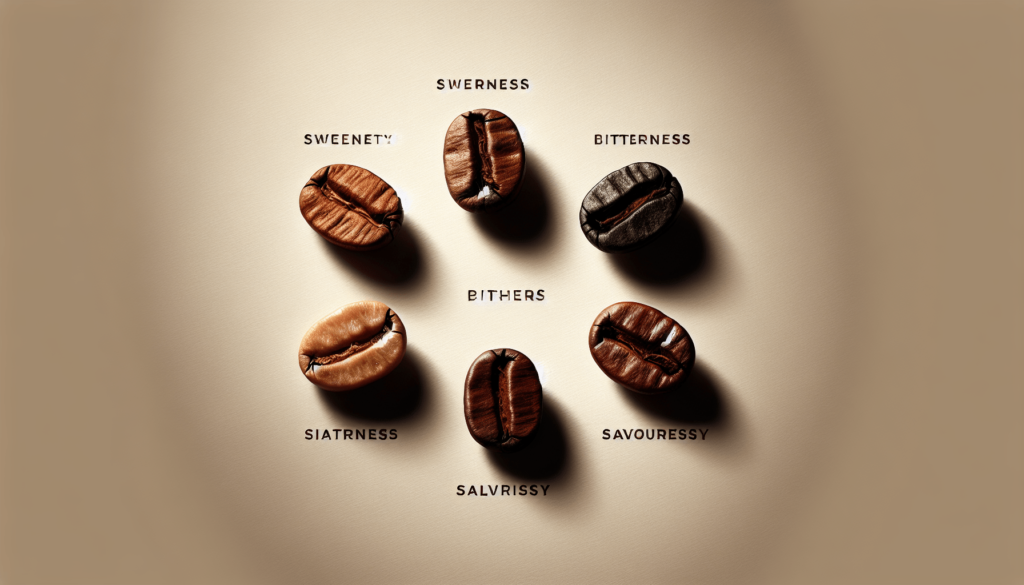Ever wondered why coffee tastes so different from one cup to another? Coffee lovers often debate the best flavors, each with their personal favorites, but did you know that coffee’s taste can be broken down into five basic categories? Understanding these foundational flavors can enhance your coffee-tasting experience and make you appreciate the intricacies of each cup.

Understanding the Basics
Before diving into the five basic tastes, it’s helpful to understand the fundamentals of coffee tasting. Coffee’s flavor is influenced by numerous factors such as the origin of the beans, the roasting process, grind size, and brewing method. Each factor plays a significant role, giving coffee its unique characteristics.
The Importance of Coffee Origin
Where a coffee bean comes from can profoundly influence its flavor. Coffee-growing regions have specific climates, soils, and altitudes that contribute to the unique tastes found in their beans.
The Roasting Process
Roasting brings out the flavors locked inside green coffee beans. As the beans roast, chemical changes occur, developing the bean’s flavors. Light roasts tend to showcase the bean’s original characteristics, while darker roasts add more roasted notes.
Grinding and Brewing Methods
The grind size and brewing method can affect the extraction process. The aim is to extract the right amount of flavors from the coffee grounds. Under-extraction results in a weak, sour taste, while over-extraction can make the coffee taste bitter and astringent.
The Five Basic Tastes of Coffee
Now let’s get to the heart of the matter. The five basic tastes of coffee are sweet, sour, salty, bitter, and umami. Each of these taste profiles can be found in coffee, though not always in the same cup.
Sweet
You might not associate sweetness with coffee, but a well-brewed cup often has a hint of natural sweetness. This taste is typically more noticeable in light roasted coffees and those originating from specific regions, like Ethiopia or Panama.
Characteristics of Sweetness
Sweetness in coffee is more about subtle undertones rather than an overpowering saccharine flavor. It may come across as hints of caramel, honey, or fruity notes such as berries and citrus.
| Coffee Region | Notable Sweetness Notes |
|---|---|
| Ethiopia | Blueberry, Strawberry |
| Panama | Honey, Citrus |
| Costa Rica | Caramel, Apple |
Sour
Sourness is a double-edged sword in the world of coffee. It can indicate either a well-balanced cup or one that’s under-extracted.
Characteristics of Sourness
A pleasant sour note can add complexity and vibrance to your coffee. It’s often experienced as a tart, fruity acidity, resembling flavors like green apple, lemon, or lime.
| Coffee Region | Notable Sourness Notes |
|---|---|
| Kenya | Blackcurrant, Grapefruit |
| Colombia | Lime, Green Apple |
| Guatemala | Lemon, Cherry |
Salty
Saltiness in coffee is less common but can be detected in certain brews. It is often more of a background note but contributes to the overall flavor profile.
Characteristics of Saltiness
A slight salty taste can enhance the other flavors in coffee, making it more rounded and balanced. It may be noticed as a kind of mineral taste in the background.
| Coffee Region | Notable Saltiness Notes |
|---|---|
| Brazil | Nutty, Mineral |
| Indonesia | Earthy, Savory |
| Ethiopia | Mildly Salty, Savory |
Bitter
Bitter is perhaps the most recognized taste in coffee. It’s often the result of the roasting process and can vary from pleasant to unpleasant depending on the balance with other flavors.
Characteristics of Bitterness
Bitterness can range from dark chocolate and nuts to an unpleasant ashy or burnt taste. Understanding how to balance bitterness with other flavors is key for a pleasurable coffee experience.
| Coffee Region | Notable Bitterness Notes |
|---|---|
| Italy | Dark Chocolate, Nuts |
| Sumatra | Earthy, Woody |
| Colombia | Cocoa, Dark Chocolate |
Umami
Umami, often described as savory, is a less-discussed but intriguing flavor in coffee. It adds depth and richness to the brew.
Characteristics of Umami
Umami flavors might remind you of broth, soy sauce, or even mushrooms. It provides a savory backdrop that can make a cup of coffee feel fuller and more satisfying.
| Coffee Region | Notable Umami Notes |
|---|---|
| Japan | Soy Sauce, Broth |
| Indonesia | Earthy, Mushroom |
| Guatemala | Full-bodied, Rich |
Enhancing Your Coffee Tasting Experience
Understanding these five tastes can transform how you enjoy coffee. Let’s explore how you can apply this knowledge to your daily coffee routine.
Choosing the Right Beans
Start by selecting beans that highlight the flavors you enjoy the most. If you prefer sweeter profiles, go for beans from regions known for their sweetness. If you enjoy a bit of tartness, opt for coffees with a pronounced acidity.
Experimenting with Brewing Methods
The brewing method can significantly impact the taste of your coffee. For example, a pour-over method often brings out the complex nuances of light-roasted beans, emphasizing their natural sweetness and acidity.
Mind the Grind Size
Adjusting the grind size can also change the flavor profile. A finer grind can enhance bitter and umami flavors, while a coarser grind might highlight sweet and sour notes.
Water Quality and Temperature
Water quality and temperature play crucial roles in coffee extraction. Using filtered water and brewing at the optimal temperature can help bring out the best flavors in your coffee.
Keeping a Coffee Journal
Keeping a coffee journal is an excellent way to track the flavors you enjoy most. Note down the origin, roast level, brew method, and any flavors you detect. Over time, you’ll start to recognize patterns and preferences.
Conclusion
Coffee is a rich and complex beverage that offers a multitude of flavors. By understanding the five basic tastes—sweet, sour, salty, bitter, and umami—you can enhance your appreciation of coffee and make more informed choices about the beans and brewing methods you use. Experimentation and mindfulness in your coffee preparation can lead to discovering new favorite flavors and a deeper enjoyment of your daily cup.

